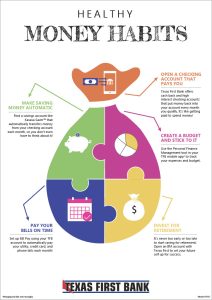Healthy Money Habits
 Luckily, no matter who you are or what situation you’re in, there are a few healthy money habits you can adopt right now to get you on the road to financial success.
Luckily, no matter who you are or what situation you’re in, there are a few healthy money habits you can adopt right now to get you on the road to financial success.
Step 1: Create a Budget and Stick to It
Many people get scared to create a budget. Don’t think of it as a punishment, but rather a partner on your journey. Creating a budget allows you to see what money is coming in and where it’s going. It forces you to think about your goals and prioritize them. Are you trying to get out of debt? Are you wanting to save for college or retirement? Or are you just looking for a way to afford a new car or vacation? Whatever it is, write it down and put them in order of importance to you.
Then, write down what income you’re bringing in and subtract your essential expenses – rent/mortgage, food, utilities, basic toiletries, insurance, and anything you rely on to earn income like a cell phone, internet, or car. Once you do that, you should have some dollars leftover. Your prioritized list of goals can help you decide where you want that money to go next.
(Note: if you do not have any discretionary dollars after taking out the essentials, we recommend you re-evaluate what you consider essential and search for money-saving options there. Could you move to a cheaper place? Eat out less? Find cheaper insurance or service providers?)
Once you’ve decided how you want to prioritize your spending, use a budgeting tool, like Personal Finance Management inside the TFB app, to keep track of how you do each month. Set a regular time – say the first of every month – to look at what you’ve spent and how you’re progressing toward your goals. Don’t beat yourself up if you don’t meet your goals one month. Simply keep tracking and adjust your spending each month to get you closer to where you want to be. A budget is meant to be a partner for you, and it’s a GREAT reality check.
Step 2: Pay Your Bills on Time
As you’re looking at your budget, we recommend one big thing: Pay your bills. On time. Every time.
This includes making the minimum payments on all of your credit cards and loans. Paying your utility bills and making at least the minimum payments on your loans/debt will help keep your credit score up and save you money from not having to pay extra interest or late fees.
Many banks make paying your bills on time easy with a feature called Bill Pay. Use Bill Pay to connect to your utilities, credit card, and loan accounts for automatic payments. You can set them up how you want – to make the minimum payment or pay the full bill – every month, and your bill gets paid without you even having to think about it!
Step 3: Maintain Bank Accounts that Pay You
In this day and age, you have a plethora of options when it comes to bank accounts. There’s no need to keep your money in an account that’s paying you next-to-nothing interest or, even worse, charging you to keep your account open. Your bank account should be working for you, not the other way around!
Consider finding a checking account like Texas First’s Kasasa Cash or Cash Back checking accounts that have no minimum balance and no monthly service fee. Once you open an account with $50, it’s yours to do with what you want. Keep whatever positive balance you’d like in it for free but know that these accounts can also PAY YOU additional interest or cash back based on your spending habits and the balance in your account.*
Accounts like these are easy to open online, so there’s almost no excuse.
Step 4: Make Savings Automatic
Once your essentials and bills are paid and your checking account is working for you, your next goal should be building a small emergency fund. Your emergency fund should be at least one month’s worth of essential expenses. You already know what this amount is because you calculated it in Step 1.
With a month of expenses in savings, you will have a little cushion in case you lose your job or someone becomes unexpectedly ill. The key here is DO NOT dip into your emergency funds unless it’s a true emergency, and if you ever have to take from the emergency fund, make sure to replenish it as soon as possible.
How do you save for an emergency fund? Well, talk to your banker! Many times they can help you set up automatic transfers that will take money from your checking account or wherever you’re receiving your paycheck every month and automatically transfer a set amount to your savings. Other than setting it up, there’s no maintenance. You can just watch your balance grow.
In addition to this, some banks offer rewards savings accounts. These accounts can be additional perks to your savings goals. There are many different ways a rewards savings account can be set up, but with an account like our Kasasa Saver account, you earn extra interest when you meet the monthly goals of your Kasasa checking account (making your money work for you!) AND the extra interest or cash back that you earn in your checking account is automatically transferred to your savings account. This is great because that extra interest or cash back was just that, extra! It’s usually not money you count on for paying off the essentials, so moving it to savings is just a nice little way of adding to your account, and every little bit helps!
Step 5: Invest for Retirement
By this step, you should have your essential expenses covered, your basic bills paid, and you’re on your way to building an emergency fund. Once you’ve got that, we recommend paying all of your utility, phone, and cable bills in FULL. Doing this will help you avoid additional fees and potentially free up some money for this next step:
Retirement!
Investing in a retirement account is a great way to set yourself up for the future. Many companies offer their own retirement accounts with an employer match. This is where your company will match what you put in, up to a certain amount. If your employer offers this, it’s usually a good idea to contribute the amount needed to get your employer’s full match. That means if your employer matches up to 5%, contribute 5% of your salary for them to match in full. That money will grow in value over the years with the goal to be able to retire comfortably.
If your employer doesn’t offer a match, look into an Individual Retirement Account (IRA). IRAs can be opened yourself, through a financial institution like Texas First Bank, to save for retirement with tax-free growth or on a tax-deferred basis. Your relationship banker should be able to walk you through the options.
After the Basics
After these basic steps, you should start feeling like you have a handle on your money. You’re paying your bills on time, you’re saving for an emergency, and you’re investing in your future. You’re a rock star!
Think about what you want to do next, and if you need help anywhere along the way, reach out to us! That’s the beauty of a community bank like Texas First. We’re here for you. We want you to succeed, and at Texas First Bank, we can give you the tools to do it!

*Terms and conditions apply. Visit the Kasasa Cash or Kasasa Cash Back product pages for more information.